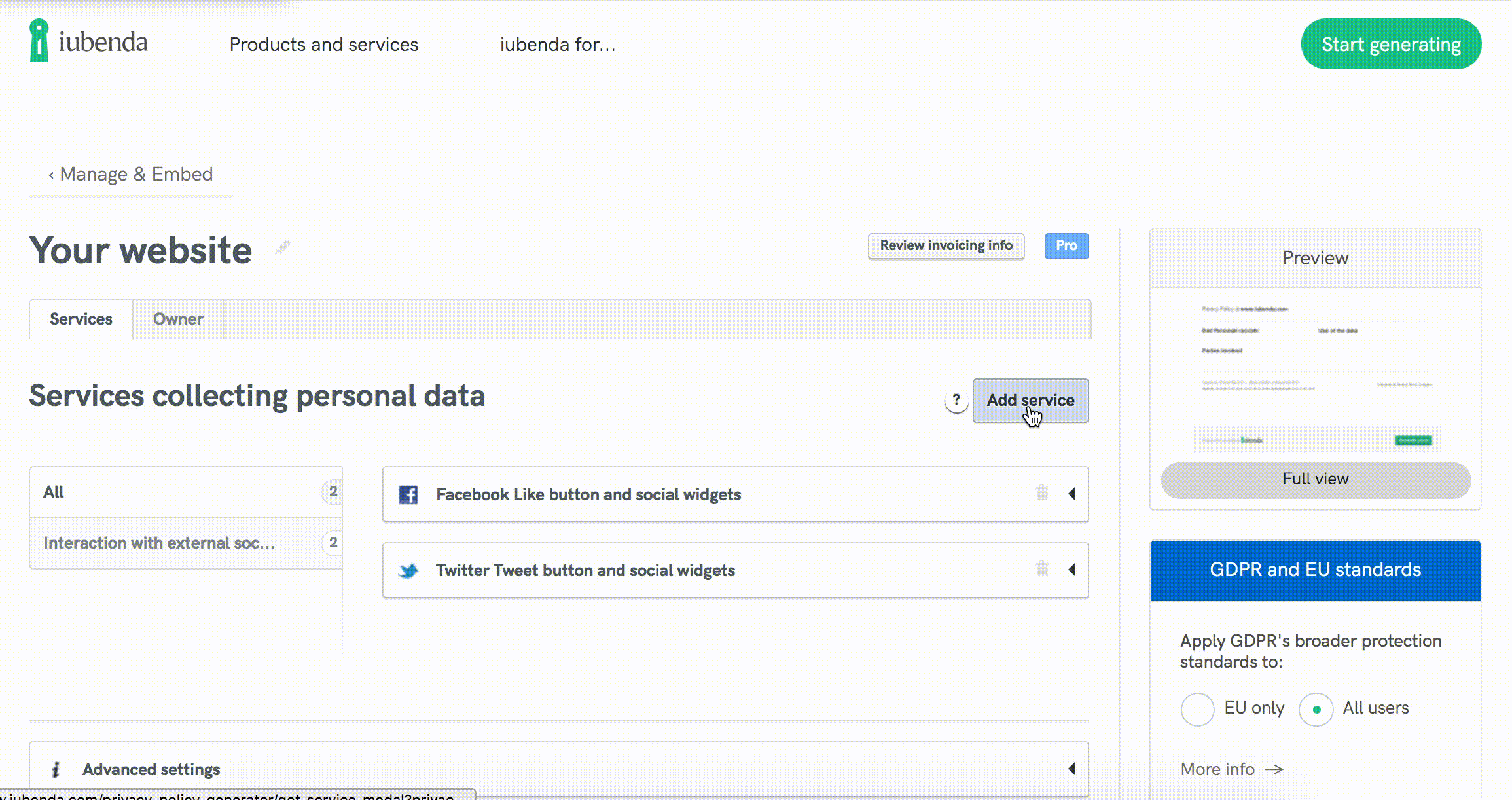If you’re a website or app owner pondering how to write a privacy policy, you’re already on the right track to safeguarding your business and respecting user data. Crafting a privacy policy that adheres to privacy policy requirements is not just about compliance; it’s about building trust with your users.
Look no further! Start now with our easy-to-use privacy policy generator! A simple way to handle compliance.
See it in action (0:37)

A privacy policy is a legal statement that details how a business collects, uses, protects, and shares the personal information of its users. An effective privacy policy is paramount for any entity dealing with personal data, ensuring compliance with various data protection laws and fostering user trust.
The privacy policy typically includes information about:
An effective privacy policy helps businesses comply with different data protection regulations. It is important for businesses to ensure that their privacy policy is easily accessible to their users and that it is up-to-date.
Every website or app that collects personal information, from email addresses to browsing behavior, must have a clear and accessible privacy policy. This is not only a legal requirement under laws like the GDPR in the European Union and the CCPA in California but also a crucial step in demonstrating your commitment to privacy.
As concerns about data privacy are increasing, a privacy policy is essential to demonstrate to your users that you respect their privacy rights and that you have the proper steps in place to protect their personal information.
In addition, many countries and regions around the world enforce laws that require website owners to have a privacy policy, including the European Union’s General Data Protection Regulation (GDPR) and the California Privacy Rights Act (CPRA).
Non-compliance with these regulations can result in fines and also have reputational consequences. Therefore, it is essential to have a privacy policy on your website to protect your business and ensure the trust of your users.
👉 Discover the Top 4 Reasons Why You Need a Privacy Policy for your website or app.
The privacy policy landscape is shaped by significant regulations, including the GDPR for EU users, the CCPA for California residents, and Brazil’s LGPD. Understanding these laws is essential for drafting a policy that meets global standards.
Let’s take a look at some of the most important regulations and laws around the world:
🇬🇧 🇪🇺 General Data Protection Regulation (GDPR):
This law, which applies to businesses that collect data from users in the European Union (EU), requires a privacy policy to disclose how personal data is collected, processed, and stored, as well as how users can control their data.
🇺🇸 California Consumer Privacy Act (CCPA):
This law applies to businesses that collect data from California residents and requires a privacy policy to disclose what categories of personal information are collected, how it’s used, and with whom it’s shared, among other things.
🇧🇷 The LGPD, or Lei Geral de Proteção de Dados:
This law applies to all businesses that process personal data in Brazil, regardless of where the business is based, and sets out rules for how businesses must handle personal data, including how it’s collected, used, processed, and shared.
🤔 Not sure which laws apply to you? Take this 1-minute quiz!
💡 Remember that the specific content required of a privacy policy differs according to applicable laws and regulations and may need to be addressed according to jurisdictional and geographic boundaries.
That’s also why you should be careful when using a generic privacy policy template, which does not include all legally-required disclosures adapted to your unique situation.
When it comes to establishing a robust online presence, having a well-crafted privacy policy for your website is non-negotiable. This document not only ensures compliance with global data protection laws but also fortifies trust between you and your users. Here’s a checklist on creating an effective privacy policy for your website.
👀 Looking for a privacy policy template for a small business? Look no further!
Developing a privacy policy for a mobile app involves unique considerations compared to websites. Mobile apps often have access to more extensive personal information through device permissions, making it crucial to address app-specific data collection practices, user permissions, and third-party data sharing transparently. Here’s a step-by-step guide to help app developers create a privacy notice tailored to the nuances of mobile app privacy concerns.
The first step in drafting your app’s privacy policy is to understand the types of data your app collects. Mobile apps can collect various types of data, including but not limited to:
Identify all the data your app collects to ensure your privacy policy covers these aspects comprehensively.
Mobile apps often require user permissions to access certain features or data on a device. Your privacy policy should clearly explain:
Be transparent about how you use the collected data and with whom you share it. This includes:
With the increasing prevalence of data breaches, ensuring and communicating how you protect user data is crucial. Your privacy policy should outline:
Empower your users by informing them of their rights regarding their personal data, including:
Mobile apps evolve rapidly, necessitating frequent updates to your privacy policy. Establish a process for reviewing and updating your policy, and inform users of significant changes. Ensure that your privacy policy is easily accessible within the app, such as in the app settings or during the onboarding process.
Privacy policy generators, such as iubenda, offer a streamlined way to produce a policy tailored to your specific needs. These tools can be a cost-effective solution for keeping your policy up to date.
